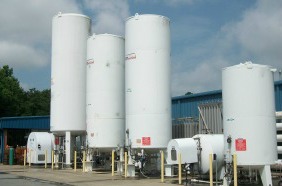Most manufacturing facilities use 1.5 to 3 times as much shielding gas as they should. The reasons for this can be found in a previous post: Control Your Shielding Gas Usage.
Before doing all the checks to see if you have leaks or other problems there is a simple way to get an idea of whether or not there is waste. This method is meant to give you an approximate usage and not an exact figure. Here it goes:

Bulk Systems are a great way to save money on shielding gas, but leaks and surges can take it all away.
1. Check your invoices or contact your gas supplier to get your usage of shielding gas for the previous 6 or 12 months.
2. Check your invoices or contact your wire supplier to get your wire usage for the same time period.
3. Come up with an average wire feed speed for all your wire welding stations
4. Determine the deposition average deposition rate in pounds per hour
5. Determine the appropriate flow, in cubic feet per hour, that the welders should be running
6. Calculate theoretical gas usage.
7. Compare to actual usage.
Example:
ABC company purchased 725,000 cubic feet of 90/10 gas in the past 12 months. During this time period they used 85,000 pounds of mig wire. The average wire feed speed for their 22 welding stations was 325ipm using .045 wire. Are they using too much gas?
1. 725,000 cubic feet of shielding gas
2. 85,000 pounds of welding wire
3. Average welding is done at 325ipm with .045 wire
4. At 325 ipm with an .045 diameter wire the deposition rate is 8.8 lbs/hr
5. A gas flow rate of 35 – 45cfh is determined to be optimal
6. At an average deposition rate of 8.8 pounds per hour it should have taken a total of (85,000/8.8) = 9,659 hours of welding to consume 85,000 lb of wire. 9,659 hours at a flow rate of 45cfh yields 434,655 cubic feet of gas usage.
7. Based on this calculations ABC is using an excess of 725,000 – 434,655 = 290, 345 cubic feet of gas. This is almost double of what they should use, so at this point it is important to evaluate why the usage is so high. Refer to post on Controlling Shielding Gas Usage
This astronomical waste is probably due to leaks, excessive gas flow or gas surges.
Have you checked your numbers to see if you are wasting gas?

What if you mix your own 90/10 shielding gas? How do you determine the total amount of purchased gases in a year? Do you simply add CO2 and Argon volumes together?
Yes. Keep in mind that your Argon and CO2 will not add up to a 90/10 split. Due to CO2 venting (in certain tanks) you will likely have more than 10% CO2.
We weld with 100% carbin dioxide. We purchase it by the pound. How can calcularte our usage versus actual purchased?
Gerard, carbon dioxide is typically sold in liquid form so it is billed in pounds. For your calculations you can assume that every pound of C02 yields 8.741 cubic feet of shielding gas. So for example, if you buy 100,000 pounds of CO2 per year your usage would be 874,100 cubic feet.
Argon can also be sold in liquid state but it is typically measured in gallons. Every gallon of argon would yield 112.5 cubic feet.
These numbers can be affected by temperature and barometric pressure, but you can go with these numbers to generate an estimate.